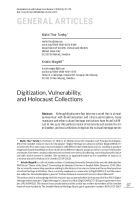Digitization, Vulnerability, and Holocaust Collections
Author(s)
Publication Name
Publication Date
Abstract
Although digitization has become a word that is almost synonymous with democratization and citizen participation, many museums and other cultural heritage institutions have found it difficult to live up to this political vision of inclusivity and access for all. In Sweden, political ambitions to digitize the cultural heritage sector are high. Yet, institutions still struggle to reconcile their previous practices with new technologies and ethical guidelines for collecting and curating material. In this article we identify, analyse, and try to find resolutions for the current gap that exists between cultural heritage practice and government policy on digitization, open access, and research ethics. By examining two Swedish examples of Holocaust collections that have not been digitized because of internal policies of secrecy and confidentiality, we attempt to demonstrate how discourses about vulnerability affect the ways in which certain archival practices resist policies of accessibility and ethical research. In order to unpack the discourses on vulnerability, Carol Bacchi’s post-structural approach to policy analysis has been used together with Judith Butler’s theories on vulnerability and resistance. In addition to understanding how cultural heritage institutions in Sweden have protected some of their collections and how this has obstructed efforts to make these collections more accessible, we also offer some suggestions on how these issues can be resolved by reimagining digitization as transformation.
Topics
Holocaust Commemoration Holocaust Education Main Topic: Holocaust and Memorial Museums Artefacts and Material Culture
Genre
Geographic Coverage
Copyright Info
available under a licence Attribution-NonCommercial-NoDerivatives 4.0 International (CC BY-NC-ND 4.0).
Original Language
Volume/Issue
6(2)
Page Number / Article Number
87-118
DOI
Bibliographic Information
Digitization, Vulnerability, and Holocaust Collections. 2020: 87-118. https://archive.jpr.org.uk/10.4467/2450050XSNR.20.012.13015




